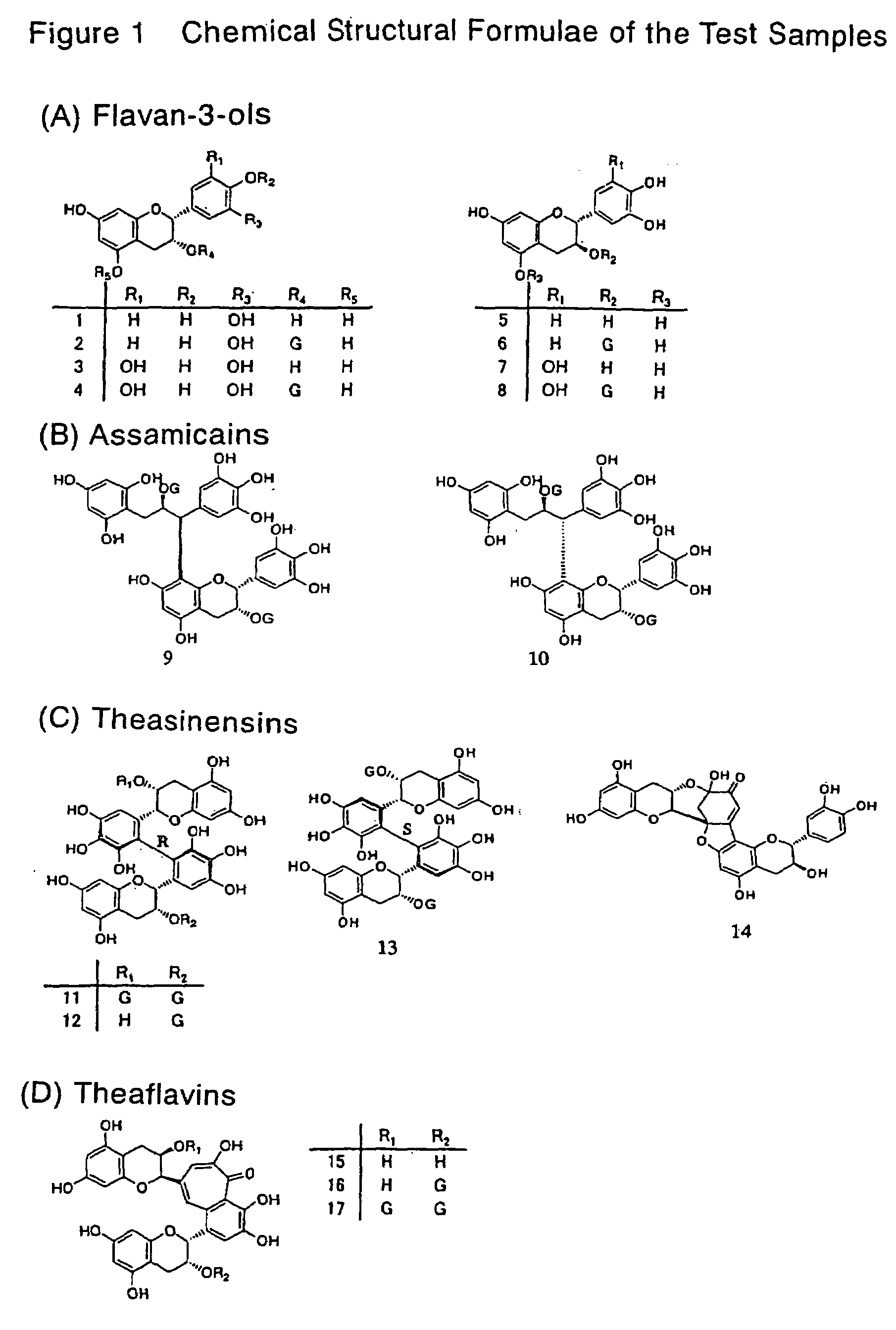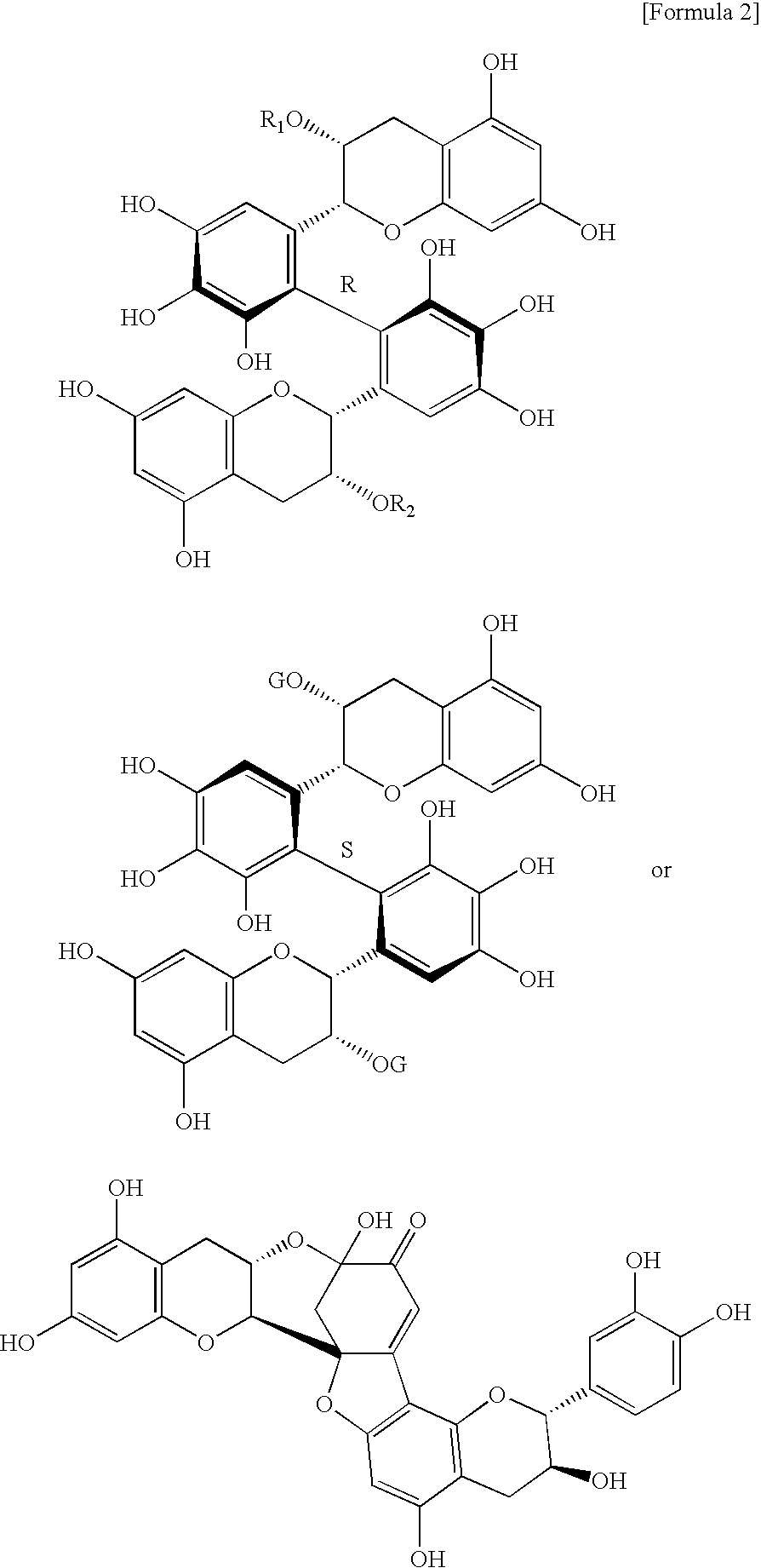Lipase Inhibitors
a technology of lipase inhibitors and inhibitors, which is applied in the field of lipase inhibitors, can solve the problems of increased stool frequency, difficult to follow in daily life, and not always safe, and achieve the effects of reducing triglycerides, inhibiting the absorption of dietary fats, and enhancing health without compromising flavor
- Summary
- Abstract
- Description
- Claims
- Application Information
AI Technical Summary
Benefits of technology
Problems solved by technology
Method used
Image
Examples
examples 1
Lipase Inhibitory Activity Assay
[0058]A lipase activity assay was performed by using the oleate ester of fluorescent 4-methylumbelliferone (4-MUO) as a substrate to measure the fluorescence of 4-methylumbelliferone produced by reaction.
[0059]The buffer used for the assay was 13 mM Tris-HCl (pH 8.0) containing 150 mM NaCl, 1.36 mM CaCl2. The enzyme assay was performed using a 0.1 M solution of the substrate 4-MUO (Sigma) in DMSO diluted 1:1000 in said buffer and a solution of porcine pancreatic lipase (Sigma) prepared at 400 U / ml also in said buffer.
[0060]An enzymatic reaction was started by adding 25 μl of the lipase / buffer solution after 50 μl of the 4-MUO / buffer solution and 25 μl of distilled water (or an aqueous solution of each sample) were added and mixed in a 96-well microplate at 25° C. After the reaction was performed for 30 minutes, the reaction was stopped by adding 100 μl of a 0.1 M citrate buffer (pH 4.2) and the fluorescence of 4-methylumbelliferone produced by the rea...
example 2
Synthesis of Dehydro-Dicatechin A
[0065]Tea leaves of Kyoken No. 129 variety (supplied from Kyoto Prefectural Tea Research Institute) (100 g) were ground in liquid nitrogen and stirred with 600 ml of an extraction buffer (adjusted to pH 7.0 with 0.01 M KH2PO4 and 0.02 M K2HPO4) and 100 ml of polyamide, and then filtered through gauze. The filtrate was centrifuged at 8000 rpm for 20 min. The supernatant (500 ml) was stirred with 500 ml of acetone precooled to −20° C., and then the mixture was allowed to stand at 4° C. for 1 hr. This solution was centrifuged at 8000 rpm, 4° C. for 20 min to give a white precipitate. This precipitate was dissolved in 100 ml of a reaction buffer (adjusted to pH 5.6 with 0.01 M citrate and 0.02 M KH2PO4) to prepare an enzymatic solution.
[0066]To 100 ml of the enzymatic solution were added 100 mg of D-(+)-catechin and 8.8 mM H2O2 and allowed to stand at 32° C. After 5 hrs, the reaction was stopped by adding 100 ml of 90% acetonitrile containing 1% TFA. Thi...
example 3
Lipase Inhibitory Activity of Catechins and Dimers Thereof
[0073]Catechins (monomers) and dimeric compounds produced by polymerization of catechins known as major polyphenols in teas were assayed for lipase inhibitory activity according to the method of Example 1. The results are shown in Table 1. The chemical structural formulae of the compounds subjected to evaluation are shown in FIG. 1. Among major catechins (8 catechins) present in teas, flavan-3-ols having a gallate moiety bonded via an ester linkage showed lipase inhibitory activity. Especially, epigallocatechin gallate (EGCG) abundantly found in teas showed the strongest activity among the major catechins.
[0074]Among dimeric polyphenols, those having a gallate group in their structure, especially dimers of EGCG were shown to have higher lipase inhibitory activity than EGCG per se.
[0075][Table 1]
TABLE 1Lipase inhibitory activity of tea-derived polyphenolsPolyphenolsIC50 (μM)Flavan-3-ols(−)-epicatechin (1)>21.6(−)-epicatechin 3...
PUM
| Property | Measurement | Unit |
|---|---|---|
| weight loss | aaaaa | aaaaa |
| weight loss | aaaaa | aaaaa |
| pH | aaaaa | aaaaa |
Abstract
Description
Claims
Application Information
 Login to View More
Login to View More - R&D
- Intellectual Property
- Life Sciences
- Materials
- Tech Scout
- Unparalleled Data Quality
- Higher Quality Content
- 60% Fewer Hallucinations
Browse by: Latest US Patents, China's latest patents, Technical Efficacy Thesaurus, Application Domain, Technology Topic, Popular Technical Reports.
© 2025 PatSnap. All rights reserved.Legal|Privacy policy|Modern Slavery Act Transparency Statement|Sitemap|About US| Contact US: help@patsnap.com



